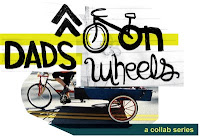"I am Kat Marriner living in Seattle, WA and I am a 45-year-old freelance graphic designer. My husband and I have been carfree for over 5 years. I use my bike to get around town most of the year, and my husband and I go on extended bicycle adventures to far-flung places around the world.
(Picture: Going to Heels on Wheels)
When did you start using a bicycle for commuting?
"I started riding my 10-speed huffy to high school when my family moved from a neighborhood near the school to an orchard just on the outskirts of Yakima, WA. It gave me freedom rather than relying on my parents to take me places."
What inspired you to start?
"I think I started by necessity when I was in high school, but it really transformed into a lifestyle choice when I was in college. I took a semester off from school, bought a Eurail pass to explore. There I fell in love with the romantic ideal of shopping in farmer’s markets and carrying dinner home in the bicycle basket. I bought a step-through “cross-bike” when I got back to college and rode it to campus and about town."
What is a day in your bicycling life like?
"I work at home with no set schedule so there is no typical day. Throughout a work week I will put on a skirt and pack my brief case into a pannier and ride downtown to meet with a client. Or I’ll take a mid-afternoon break and pedal to the produce stand or some other errand. Today I rode downtown to meeting at a coffee shop then boarded an Amtrak train with my bicycle to Portland for the weekend. I got soaked in the rain, and the rain is typical certain times of the year!"
Do you recommend cycling to friends/family members/others? Have any taken you up on it?
"I am a cheerleader to friends who show an interest in taking any kind of local (or extended) trip by bike. I’ve started encouraging more women to bring bikes into their everyday life. We meet monthly for a “Heels on Wheels” dinner out on the town. To my knowledge, none of my family members ride a bike."
What kind of bike are you currently riding?
"I ride a Rodriguez mountain bike with more touring dimensions. I actually know very little about bikes. What I love about this bike is that I feel very competent on it. When I first got it, it felt like I could fly."
(Roadside stop on the 3 month tour of Colombia and Venezuela.)
In your opinion, what’s the best part about cycling?
"The absolute best is riding about town on warm, sunny day, mid-week and feeling like I’m in on a secret. That secret is that I get to experience life while car drivers are in their tin can. I smell the flowers in bloom, feel the warmth of the sun, and enjoy a breeze in my face. I notice the shape of trees overhead, the sound of kids laughing on the playground, the smell of someone cooking garlic. This is all because I’m out there with all my senses soaking in my surroundings."
What’s the worst?
"The worst part is when a driver looks right through me as if I don’t exist, then pulls out right in front of me. It makes me sad when that driver has kids in their car and they just taught those kids by example."
What are three pieces of advices you would give to someone starting/considering commuting by bike?
"First, I suggest not thinking about commuting by bike but integrating short bicycle trips into your everyday errands close to home. Short trips within our neighborhoods are the place to gain confidence and experience. Once someone is comfortable pedaling familiar streets and confident riding further distances, then commuting to work is a more feasible option. Second, a cyclist should always assume that drivers do not see you. Make eye contact with cars in the cross streets, look over your shoulder for a vehicle ready to turn right and cross your lane. Third: ride predictably. Make it easy for drivers to know what you are about to do and work towards a mutual respect on the road."
Anything else you would like to add?
"I consider myself an ambassador of cycling when I’m on the road. I want it to look like I’m having fun because it is fun. Reward considerate drivers with a wave, a thank you, or a big smile. I remember the friendly gestures – an oncoming car waiting so I can turn left, someone stopping so I can cross a busy street, even a thumbs up as I slowly pedal my bicycle loaded with groceries up the hill — so maybe drivers will remember my friendly wave too. Those gestures make me feel better about my life on two wheels, and I’d rather focus on the good will out there instead of the jerks that could ruin my day."
Kat and her husband, adventure cycling author and lecturer Willie Weir, live in Seattle where they live a Car-Free life!
Their blog is a good place to share in their adventures. http://www.yellowtentadventures.com/
"In a couple of weeks, we leave for a 3 month bike trip through Portugal (and a little Spain) and our web site will have posts from the road instead of posts from the carfree life, but one definitely influenced the other!!"
Thank you for sharing Kat and have a great trip!!!






















